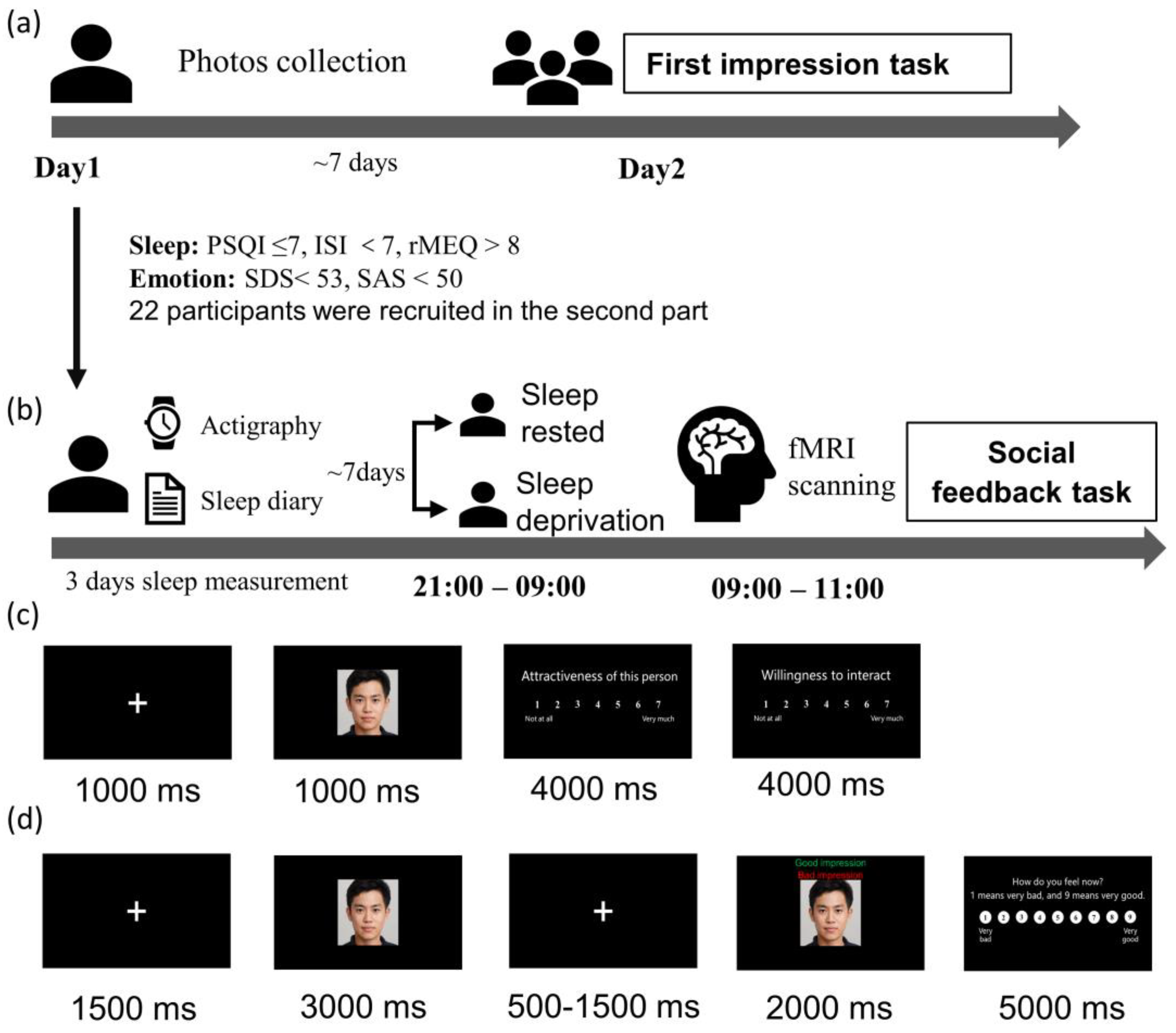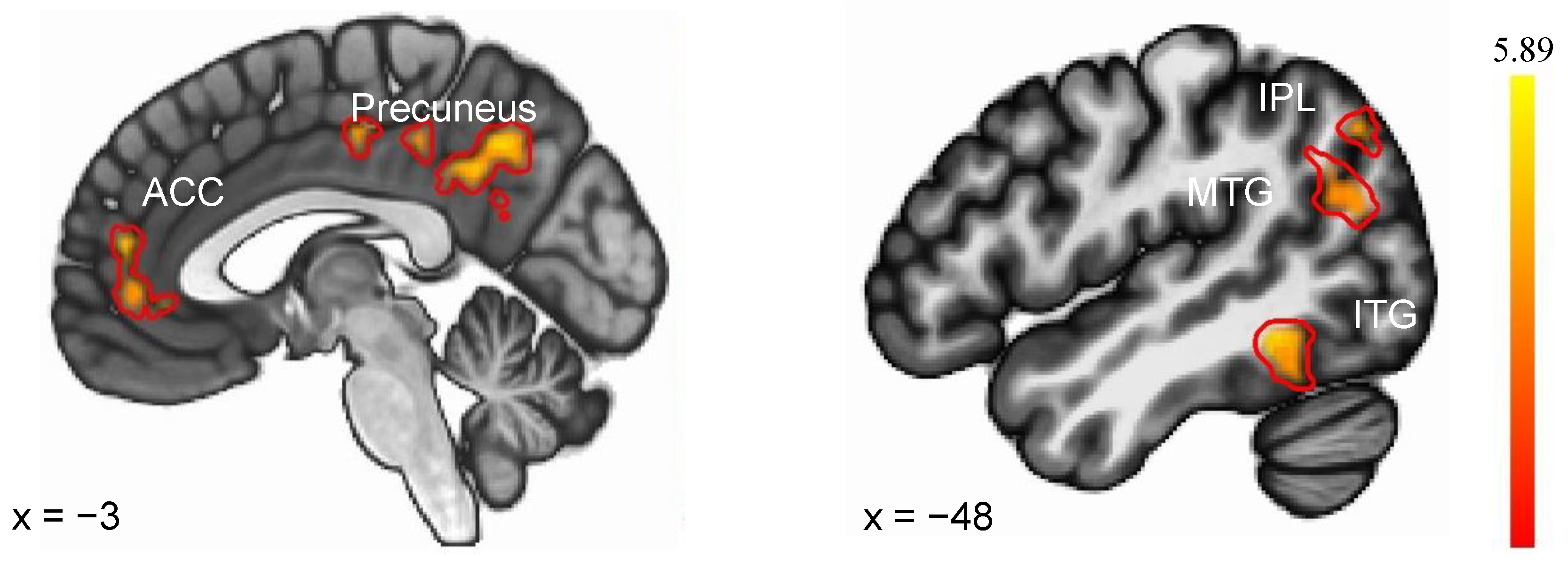The Impact of Sleep Deprivation on Brain Networks in Response to Social Evaluation Tasks
Abstract
1. Introduction
2. Materials and Methods
2.1. Participants
2.2. Experimental Design and Procedure
2.2.1. Stimuli
2.2.2. First Impression Task
2.2.3. Sleep Manipulation
2.2.4. Social Feedback Task
2.2.5. Image Acquisition
2.3. Behavioral Statistical Analysis
2.4. Imaging Statistical Analysis
2.4.1. Data Preprocessing
2.4.2. Whole-Brain Analysis
2.4.3. Functional Connectivity
3. Results
3.1. First Impression Task of the Social Evaluation Task Experiment
3.2. Social Feedback Task of Social Evaluation Task Experiment
3.2.1. Whole-Brain Analysis
3.2.2. gPPI Analysis
4. Discussion
4.1. Negative Trend in Social Involvement
4.2. Changes in Self-Referential Processes after Sleep Deprivation
4.3. Limitations and Future Implications
5. Conclusions
Author Contributions
Funding
Institutional Review Board Statement
Informed Consent Statement
Data Availability Statement
Acknowledgments
Conflicts of Interest
References
- Yang, S.; Tian, Y.; He, Q.; Qiu, J.; Feng, T.; Chen, H.; Lei, X. Enhanced anti-correlation between the dorsal attention and default-mode networks: A resting-state fMRI study of acute insomnia. Neuroscience 2021, 467, 47–55. [Google Scholar] [CrossRef]
- Mi, Y.; Lei, X. Sleep Loss and Lack of Social Interaction: A summary interview. Brain-Appar. Commun. A J. Bacomics 2022, 2, 2163593. [Google Scholar] [CrossRef]
- Goldstein-Piekarski, A.N.; Greer, S.M.; Saletin, J.M.; Walker, M.P. Sleep Deprivation Impairs the Human Central and Peripheral Nervous System Discrimination of Social Threat. J. Neurosci. 2015, 35, 10135–10145. [Google Scholar] [CrossRef] [PubMed]
- Simon, E.B.; Walker, M.P. Sleep loss causes social withdrawal and loneliness. Nat. Commun. 2018, 9, 3146. [Google Scholar] [CrossRef] [PubMed]
- Axelsson, J.; Ingre, M.; Kecklund, G.; Lekander, M.; Wright, K.P., Jr.; Sundelin, T. Sleepiness as motivation: A potential mechanism for how sleep deprivation affects behavior. Sleep 2020, 43, zsz291. [Google Scholar] [CrossRef] [PubMed]
- Holding, B.C.; Sundelin, T.; Schiller, H.; Åkerstedt, T.; Kecklund, G.; Axelsson, J. Sleepiness, sleep duration, and human social activity: An investigation into bidirectionality using longitudinal time-use data. Proc. Natl. Acad. Sci. USA 2020, 117, 21209–21217. [Google Scholar] [CrossRef]
- Van Schie, C.C.; Chiu, C.-D.; Rombouts, S.A.R.B.; Heiser, W.J.; Elzinga, B.M. When compliments do not hit but critiques do: An fMRI study into self-esteem and self-knowledge in processing social feedback. Soc. Cogn. Affect. Neurosci. 2018, 13, 404–417. [Google Scholar] [CrossRef]
- Davis, M.M.; Modi, H.H.; Skymba, H.V.; Finnegan, M.K.; Haigler, K.; Telzer, E.H.; Rudolph, K.D. Thumbs up or thumbs down: Neural processing of social feedback and links to social motivation in adolescent girls. Soc. Cogn. Affect. Neurosci. 2022, 18, nsac055. [Google Scholar] [CrossRef]
- Guyer, A.E.; Choate, V.R.; Pine, D.S.; Nelson, E.E. Neural circuitry underlying affective response to peer feedback in adolescence. Soc. Cogn. Affect. Neurosci. 2012, 7, 81–92. [Google Scholar] [CrossRef]
- Williams, K.D.; Nida, S.A. Ostracism: Consequences and coping. Curr. Dir. Psychol. Sci. 2011, 20, 71–75. [Google Scholar] [CrossRef]
- Eisenberger, N.I. The pain of social disconnection: Examining the shared neural underpinnings of physical and social pain. Nat. Rev. Neurosci. 2012, 13, 421–434. [Google Scholar] [CrossRef] [PubMed]
- Sundelin, T.; Lekander, M.; Sorjonen, K.; Axelsson, J. Negative effects of restricted sleep on facial appearance and social appeal. R. Soc. Open Sci. 2017, 4, 160918. [Google Scholar] [CrossRef]
- van Egmond, L.T.; Meth, E.M.; Bukhari, S.; Engström, J.; Ilemosoglou, M.; Keller, J.A.; Zhou, S.; Schiöth, H.B.; Benedict, C. How Sleep-Deprived People See and Evaluate Others’ Faces: An Experimental Study. Nat. Sci. Sleep 2022, 14, 867. [Google Scholar] [CrossRef]
- Somerville, L.H.; Heatherton, T.F.; Kelley, W.M. Anterior cingulate cortex responds differentially to expectancy violation and social rejection. Nat. Neurosci. 2006, 9, 1007–1008. [Google Scholar] [CrossRef] [PubMed]
- Couto, B.; Sedeño, L.; Sposato, L.A.; Sigman, M.; Riccio, P.M.; Salles, A.; Lopez, V.; Schroeder, J.; Manes, F.; Ibanez, A. Insular networks for emotional processing and social cognition: Comparison of two case reports with either cortical or subcortical involvement. Cortex 2013, 49, 1420–1434. [Google Scholar] [CrossRef]
- Uddin, L.Q.; Nomi, J.S.; Hébert-Seropian, B.; Ghaziri, J.; Boucher, O. Structure and function of the human insula. J. Clin. Neurophysiol. Off. Publ. Am. Electroencephalogr. Soc. 2017, 34, 300. [Google Scholar] [CrossRef]
- Gilbert, L.R.; Pond, R.S., Jr.; Haak, E.A.; DeWall, C.N.; Keller, P.S.; Psychology, C. Sleep problems exacerbate the emotional consequences of interpersonal rejection. J. Soc. Clin. Psychol. 2015, 34, 50–63. [Google Scholar] [CrossRef]
- Gordon, A.M.; Del Rosario, K.; Flores, A.J.; Mendes, W.B.; Prather, A.A. Bidirectional links between social rejection and sleep. Psychosom. Med. 2019, 81, 739–748. [Google Scholar] [CrossRef]
- Tian, Y.; Vitiello, M.V.; Wang, H.; Wang, Y.; Dong, D.; Xu, H.; Yu, P.; Qiu, J.; He, Q.; Chen, H.; et al. Risk of insomnia during COVID-19: Effects of depression and brain functional connectivity. Cereb. Cortex 2023, 33, bhad016. [Google Scholar] [CrossRef]
- Siegel, J.S.; Power, J.D.; Dubis, J.W.; Vogel, A.C.; Church, J.A.; Schlaggar, B.L.; Petersen, S.E. Statistical improvements in functional magnetic resonance imaging analyses produced by censoring high-motion data points. Hum. Brain Mapp. 2014, 35, 1981–1996. [Google Scholar] [CrossRef]
- Nieto-Castanon, A. Handbook of Functional Connectivity Magnetic Resonance Imaging Methods in CONN; Hilbert Press: Boston, MA, USA, 2020. [Google Scholar]
- Jenkinson, M.; Beckmann, C.F.; Behrens, T.E.J.; Woolrich, M.W.; Smith, S.M. Fsl. NeuroImage 2012, 62, 782–790. [Google Scholar] [CrossRef] [PubMed]
- Kaiser, M.D.; Yang, D.Y.J.; Voos, A.C.; Bennett, R.H.; Gordon, I.; Pretzsch, C.; Beam, D.; Keifer, C.; Eilbott, J.; McGlone, F.; et al. Brain mechanisms for processing affective (and nonaffective) touch are atypical in autism. Cereb. Cortex 2016, 26, 2705–2714. [Google Scholar] [CrossRef] [PubMed]
- Raichle, M.E. The brain’s default mode network. Annu. Rev. Neurosci. 2015, 38, 433–447. [Google Scholar] [CrossRef] [PubMed]
- Lavidor, M.; Weller, A.; Babkoff, H. How sleep is related to fatigue. Br. J. Health Psychol. 2003, 8, 95–105. [Google Scholar] [CrossRef]
- Zimmer-Gembeck, M.J.; Gardner, A.A.; Hawes, T.; Masters, M.R.; Waters, A.M.; Farrell, L.J. Rejection sensitivity and the development of social anxiety symptoms during adolescence: A five-year longitudinal study. Int. J. Behav. Dev. 2021, 45, 204–215. [Google Scholar] [CrossRef]
- Davey, C.G.; Pujol, J.; Harrison, B.J. Mapping the self in the brain’s default mode network. NeuroImage 2016, 132, 390–397. [Google Scholar] [CrossRef]
- Aryutova, K.; Paunova, R.; Kandilarova, S.; Stoyanova, K.; Maes, M.H.J.; Stoyanov, D. Differential aberrant connectivity of precuneus and anterior insula may underpin the diagnosis of schizophrenia and mood disorders. World J. Psychiatry 2021, 11, 1274. [Google Scholar] [CrossRef]
- Dorrian, J.; Centofanti, S.; Smith, A.; McDermott, K.D. Self-regulation and social behavior during sleep deprivation. Prog. Brain Res. 2019, 246, 73–110. [Google Scholar]
- Gunther Moor, B.; van Leijenhorst, L.; Rombouts, S.A.R.B.; Crone, E.A.; Van der Molen, M.W. Do you like me? Neural correlates of social evaluation and developmental trajectories. Soc. Neurosci. 2010, 5, 461–482. [Google Scholar] [CrossRef]
- Kusztor, A.; Raud, L.; Juel, B.E.; Nilsen, A.S.; Storm, J.F.; Huster, R.J. Sleep deprivation differentially affects subcomponents of cognitive control. Sleep 2019, 42, zsz016. [Google Scholar] [CrossRef]
- Dixon, M.L.; Moodie, C.A.; Goldin, P.R.; Farb, N.; Heimberg, R.G.; Zhang, J.; Gross, J.J. Frontoparietal and default mode network contributions to self-referential processing in social anxiety disorder. Cogn. Affect. Behav. Neurosci. 2022, 22, 187–198. [Google Scholar] [CrossRef] [PubMed]
- Lou, Y.; Lei, Y.; Mei, Y.; Leppänen, P.H.T.; Li, H. Review of abnormal self-knowledge in major depressive disorder. Front. Psychiatry 2019, 10, 130. [Google Scholar] [CrossRef] [PubMed]
- Linhartová, P.; Látalová, A.; Kóša, B.; Kašpárek, T.; Schmahl, C.; Paret, C. fMRI neurofeedback in emotion regulation: A literature review. NeuroImage 2019, 193, 75–92. [Google Scholar] [CrossRef] [PubMed]




| Poor Sleepers 10 M/41 | Normal Sleepers 11 M/37 | t | p | |
|---|---|---|---|---|
| Age | 19.68 ± 1.54 | 19.54 ± 1.35 | 0.427 | 0.670 |
| KSS | 4.74 ± 0.13 | 4.70 ± 0.15 | 0.206 | 0.837 |
| Social anxiety | 14.22 ± 4.93 | 13.30 ± 4.93 | 0.825 | 0.412 |
| Rejection sensitivity | 9.97 ± 2.61 | 10.03 ± 2.89 | −0.087 | 0.931 |
| Facial appearance | 2.88 ± 0.89 | 3.23 ± 0.73 | −1.864 | 0.066 |
| Willingness to socialize | 3.06 ± 0.95 | 3.50 ± 0.81 | −2.194 | 0.031 |
| Region Labels | x | y | z | Cluster Size | t | p (ClusterFWE) |
|---|---|---|---|---|---|---|
| N: NF > PF | ||||||
| None | ||||||
| SN: PF > NF | ||||||
| L Superior frontal gyrus | −14 | 40 | 36 | 179 | 7.85 | <0.001 |
| L Precentral gyrus | −28 | −22 | 56 | 471 | 6.46 | <0.001 |
| R Postcentral gyrus | 48 | −32 | 40 | 127 | 6.47 | <0.001 |
| R Superior frontal gyrus | 18 | 32 | 44 | 151 | 5.92 | <0.001 |
| L Middle cingulate cortex | −2 | −34 | 42 | 221 | 5.89 | <0.001 |
| L Inferior parietal gyrus | −50 | −38 | 56 | 102 | 5.95 | <0.001 |
| L Inferior parietal gyrus | −50 | −70 | 42 | 88 | 5.38 | <0.001 |
| L Cingulate cortex | −2 | −34 | 42 | 233 | 5.91 | <0.001 |
| L Precuneus | −4 | −60 | 42 | 87 | 5.34 | <0.001 |
| SD: NF > PF | ||||||
| R Inferior frontal gyrus | 48 | 24 | −2 | 292 | 4.86 | <0.005 |
| R Cuneus | 14 | −70 | 18 | 244 | 4.49 | <0.005 |
| SD: PF > NF | ||||||
| None |
| Region Labels | x | y | z | Cluster Size | t |
|---|---|---|---|---|---|
| SN > SD | |||||
| None | |||||
| SD > SN | |||||
| L Superior Parietal Lobule | −34 | −76 | 46 | 266 | 5.89 |
| L Inferior Parietal Lobule | −46 | −70 | 42 | ||
| L Precuneus | −6 | −58 | 44 | 1409 | 5.11 |
| L Inferior temporal gyrus | −48 | −48 | −10 | 751 | 4.93 |
| L Medial frontal gyrus | −6 | 52 | 14 | 314 | 4.74 |
| L Anterior cingulate | −4 | 38 | −4 | ||
| R Anterior cingulate | 6 | 44 | 0 | ||
| L Middle temporal gyrus | −38 | −66 | 22 | 283 | 4.08 |
| Region Labels | x | y | z | Cluster Size | t |
|---|---|---|---|---|---|
| Seed: R insula | |||||
| precuneus | 6 | −52 | 54 | 177 | 5.79 |
| Seed: L insula | |||||
| None |
Disclaimer/Publisher’s Note: The statements, opinions and data contained in all publications are solely those of the individual author(s) and contributor(s) and not of MDPI and/or the editor(s). MDPI and/or the editor(s) disclaim responsibility for any injury to people or property resulting from any ideas, methods, instructions or products referred to in the content. |
© 2023 by the authors. Licensee MDPI, Basel, Switzerland. This article is an open access article distributed under the terms and conditions of the Creative Commons Attribution (CC BY) license (https://creativecommons.org/licenses/by/4.0/).
Share and Cite
Mi, Y.; Duan, H.; Xu, Z.; Lei, X. The Impact of Sleep Deprivation on Brain Networks in Response to Social Evaluation Tasks. Brain Sci. 2023, 13, 1122. https://doi.org/10.3390/brainsci13081122
Mi Y, Duan H, Xu Z, Lei X. The Impact of Sleep Deprivation on Brain Networks in Response to Social Evaluation Tasks. Brain Sciences. 2023; 13(8):1122. https://doi.org/10.3390/brainsci13081122
Chicago/Turabian StyleMi, Yiqi, Huimin Duan, Ziye Xu, and Xu Lei. 2023. "The Impact of Sleep Deprivation on Brain Networks in Response to Social Evaluation Tasks" Brain Sciences 13, no. 8: 1122. https://doi.org/10.3390/brainsci13081122
APA StyleMi, Y., Duan, H., Xu, Z., & Lei, X. (2023). The Impact of Sleep Deprivation on Brain Networks in Response to Social Evaluation Tasks. Brain Sciences, 13(8), 1122. https://doi.org/10.3390/brainsci13081122







